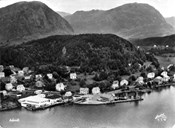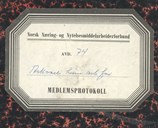The first factories
In the autumn of 1919, a cannery was built at the steamship quay at Askvoll, the "Askevold Preserving Co.". The principal owners were from Stavanger, which was the centre of the canning industry in Norway. In May 1920, the factory burnt down. Nearby, Askvoll Canning A/S was established in 1925, also by investors from Stavanger. The factory managed by Martin Dahle from Stavanger made tinned products of brisling, small herring, and crab. A tannery for seines and other fishing equipment was also established..
The canning industry in changing times
The canning industry grew fast, and in 1933 there were 200 factories in the country. At Askvoll and elsewhere, they were cornerstones in local centres along the west coast. But in the 1930s, this industry had built up an overcapacity for the raw material and the market. The factory at Askvoll was sold to the Bergenhus Canning Co.. From 1969, the Norbest Canning Co. was the owner until Norway Foods took over in 1981.
The production
The canning industry at Askvoll was based on brisling in the summer, crab in the autumn, and herring from November to March. There were occasional stops in the operations for a few weeks between these seasons. The main products were sardines and kippered herring. "Fish balls" were produced into the 1960s. A by-product was milt from the fat herring, which was tinned, steamed, and exported to America and Japan. In the same way cod milt was treated, which was transported in barrels from Lofoten. The tinning of crab was discontinued when Norway Foods took over in 1981. This production was moved to the facility at Grytøyra, but was closed down the following year.
Modernisation
A cold storage facility was installed in 1972. Before that time frozen raw materials were brought in from other places. The frozen raw material often came in blocks, and the factory had a defrosting facility. Around 1975, the factory was modernised, and tins and fish were brought in on conveyor belts, the fish being put in tins by women with quick fingers.
Restructuring of the sardine industry
In the 1950s, the number of factories had fallen to about 150 and down to 39 in 1970. The main causes were higher costs in Norway than in competing countries, a glut in the market , and periodic lack of raw materials. The canning industry was drastically restructured, which brought the factory at Askvoll into the recently established company of Norway Foods in 1981. The objective was rationalised production and marketing. The new company comprised all the remaining 16 Norwegian sardine factories, ten in the county of Hordaland and three in Sogn og Fjordane.
The end
The disadvantage of the Askvoll factory was that it was situated on the outskirts of Norway Foods' main activity, which was the cannery in Stavanger. The factory at Askvoll was closed down in 1992. Then there were only three remaining sardine factories in Norway Foods. The facility at Askvoll was sold, and only a part of it has since been used for storage.
Over several decades the canneries had been cornerstones in the places of their location, with mainly female employees. Before it was closed down, the cannery at Askvoll employed 60-70 persons.





